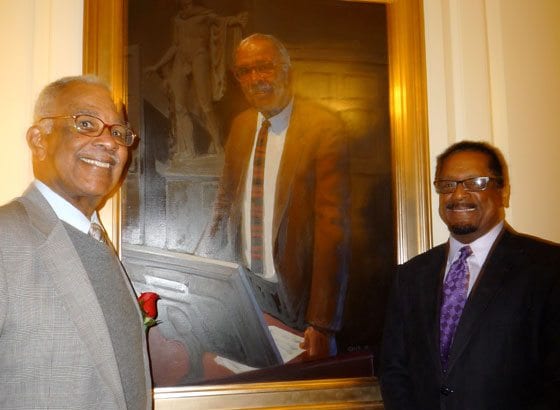
CAMBRIDGE — When Chester Middlebrook Pierce showed up in Harvard Square in 1944, he never thought he’d spend his entire career under the Crimson canopy.
The dedication of Pierce’s portrait in one of Harvard’s undergraduate dorms guarantees that the retired medical school professor will always remain a watchful presence at his alma mater.
“I am so grateful for all this,” said the soft-spoken psychiatrist as tears filled his eyes.
He looked around the room at the dozens of family members, friends and colleagues who were gathered to witness the unveiling of a gold-framed oil portrait commissioned to honor his 41 years of service to Harvard.
“I’m used to giving lectures but this time I’m speechless,” said the long-time professor of psychiatry and education.
Just behind Pierce, members of Harvard’s varsity football team crowded around the painting of the lanky scholar standing at a lectern in the Ether Dome at Massachusetts General Hospital.
They came to the Junior Common Room at Lowell House to pay tribute to the lineman who starred on the 1947 team, which refused to play Virginia until the Cavaliers dropped their opposition to competing against the integrated Harvard squad.
More than 60 years after last donning pads and helmet with the likes of young Robert F. Kennedy, Pierce recalls his gridiron memories as among his fondest. That’s why he chose to wear a Harvard Varsity Club tie for the painting. Lowell House, where he lived as an undergraduate and where his portrait was unveiled, is equally cherished.
Pierce, whose parents worked as domestics on Long Island, graduated from Harvard in 1948 and earned a medical degree in 1952. He spent a year as a research fellow in psychiatry and 41 years as a professor. His brother, Samuel Pierce, was a Cornell graduate who served as U.S. Secretary of Housing and Urban Development in the Reagan cabinet.
House Master Diana Eck, a religion professor who presides over the stately residential hall, welcomed Pierce and his family back to Lowell House and said it was critical that Harvard expand its portrait gallery beyond the mostly white faces adorning its common rooms, lecture halls, libraries and departmental offices.
“It’s really important to Harvard to update our image, which has changed so much from the early days,” she said. Pointing out the window to the Georgian brick courtyard and soaring bell-tower, Eck noted that Pierce’s portrait, flanking the fireplace, would overlook students coming and going from the arched entryway he used every day as an undergraduate.
The image makeover at the nation’s oldest university is due to the efforts of the Harvard Foundation for Intercultural and Race Relations, which had already unveiled nine portraits of individuals who served Harvard for more than 25 years and contributed significantly to the diversity of campus life.
The portraiture project was launched by Harvard Foundation Director S. Allen Counter, a professor of neurology, after a 2002 survey of 750 portraits on campus showed that 690 were of white men. Only two, commissioned in the 1980s and 1990s, depicted people of color.
Recent subjects of the project include the late dean of students, Archie Epps III, the Rev. Peter J. Gomes and David Evans, a senior admissions officer under whose tenure “more minorities were admitted to Harvard in the last 35 years than in the last 350,” said Counter.
Rulan Pian, a Chinese-American music professor who served as Harvard’s first minority house master, has also been honored along with L. Fred Jewett, a white man who headed the Harvard admissions office for decades.
A portrait of Caleb Cheeshahteaumuck, who in 1665 became the first Native American to graduate from Harvard, will be unveiled next month. In the coming years, the foundation will add a portrait of Venus Whittemore, a slave purchased by Harvard President Benjamin Wadsworth, who identified her in a 1726 diary entry as a “negro wench.”
“We simply wish to place portraits of persons of color and others who’ve served Harvard among the panoply of portraits that already exists,” said Counter in the elegant Lowell House meeting room adorned with classical columns and murals of colonial life.
“We will not displace any portrait, just simply add to them.”


![Banner [Virtual] Art Gallery](https://baystatebanner.com/wp-content/uploads/2024/04/Cagen-Luse_Men-at-store-e1713991226112-150x150.jpg)



